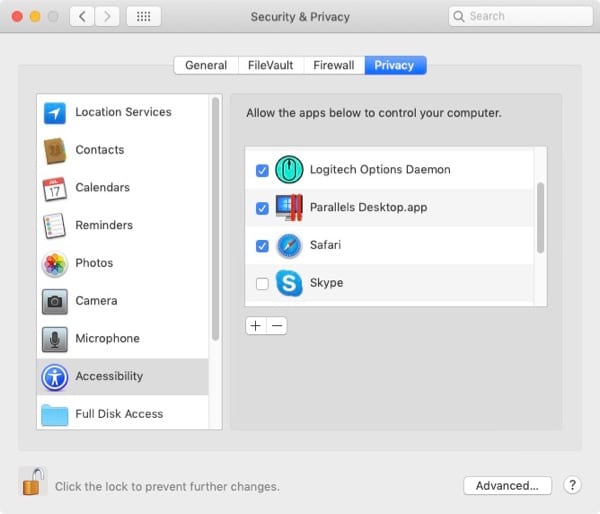I had macOS Mojave 10.14 running on my 2015 MacBook all along, even the betas before final release, but the holidays brought the opportunity to upgrade my production Mac Pro to Mojave as well. I had some interesting experiences that may be of interest to those who have delayed this upgrade.

Experiences
Upgrading. First, I should note that the upgrade from High Sierra 10.13.6 to Mojave 10.14.2 went beautifully. Of course, I was all backed up with Time Machine and Carbon Copy Cloner, and I had done a First Aid check on my boot SSD via Disk Utility. But it went smoothly, as I believe it did for most users.
App Access. What I had the most fun with was the more thorough app authorization required in Mojave. My first encounter was the most striking and annoying. My Logitech MX Anywhere mouse wouldn’t scroll (though it would point) until I included Logitech Options in System Preferences > Security & Privacy > Privacy > Accessibility. This, of course, wasn’t an issue on the MacBook.

I went through a similar but more complicated proces to enable Spam Sieve. I had also to enable the spamsieve.mailbundle in the Mail app’s general preferences, plug-in manager. I went through a similar process for Text Expander.
I mention this procedure because I am sure that, back in September, there was a lot of literature about Mojave’s additional app authorizations. But if you wait, as I did, the articles explaining it all fall off one’s radar. This is one reason to, nowadays, upgrade ::cough:: soon after the rest of the community does, even on a production Mac. macOS security in 10.15 will likely demand the same kind of user attentions as it introduces app notarizations and leaves 32-bit apps behind once and for all.
Screenshots. On my MacBook, I knew that screenshots get triggered differently, but I ignored those intermediate thumbnails. On a production Mac, it was high time to get rid of them. I had to review our Melissa Holt’s excellent tip. “How to Change Mojave’s Default Screenshot Location.” This article also explains how to suppress the intermediate thumbnail.
Speed. App launches seem to take longer in Mojave, at least for the first time. It feels like Mojave is doing Gatekeeper checking. Afterwards things go better. I’ve never noticed the effect so dramatically in previous versions of macOS. I could be wrong.
A New Mac. My wife also got caught up in one Mojave intricacy. On a new Mac, that shipped with Mojave, she tried to format a new external hard disk for Time Machine. I quickly got a call for help because Disk Utility app wasn’t showing the desired format options.
It turns out that, on a new Mac, Disk Utility has an undesirable default on the upper left “View” option. Jeff Gamet explained this nicely last summer. “How to Format a Drive with GUID for macOS High Sierra, Mojave Installation.” Once you change it, however, it sticks as the default. The app’s out-of-the-box default is, I believe, wrongheaded.
Final Thoughts
The upgrade to Mojave has been a joy for me. But I worry that that some inexperienced users, new to Mac, may be a bit frustrated by the app accessibility bookkeeping. I know Apple takes pains to make things easy and intuitive, but what I’m seeing is the need for most developers to carefully revise their Mojave apps to walk the new user through some potentially uncomfortable permissions. Perhaps I’m over reacting.
In the end, thanks Apple for making our Macs safer and more secure. And making the macOS upgrade process rock solid, not just in Mojave, but for years and years now.
Kind of sad. My upgrade a few months back after Mojave went smoothly at first. I upgraded 3 macs.
Unfortunately, after a couple of upgrades ran on my main iMac, my iMac will drop its wired network connection. It doesn’t seem to do it consistently.
Could drop connection in 10 minutes or a few hours, but generally if I leave it on for a while, the network connection dies.
Once I reboot, everything is connected just fine at first, but eventually the connection will fail.
Not certain why, but it is very frustrating.
I want my rock solid network connection again. This is maddening.
Same issue with VMware – it was kind of baffling for a while.
Deal breaker here. No macOS upgrade beyond 10.12 Sierra until Apple releases full APFS documentation-specifications, so that DiskWarrior 6 to rebuild directory of such disks is released. Additionally, Time Machine 2 supporting APFS. 2019? 2020? Ever?
According to Alsoft they have:
“•What’s in the works
The next major release of DiskWarrior will include the ability to rebuild APFS disks. Apple has recently released the APFS format documentation. Our developers are now using that documentation to update DiskWarrior to be able to safely rebuild APFS disks.”
So Alsoft is now working on building the app for that functionality. I’m sure this year it will be out.